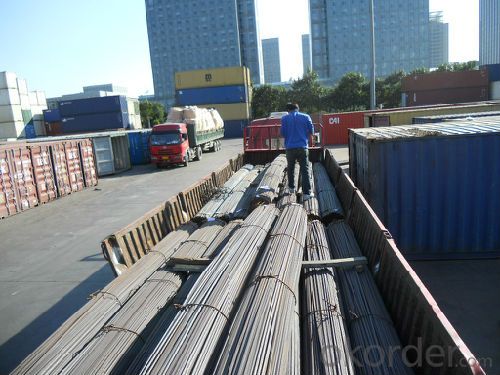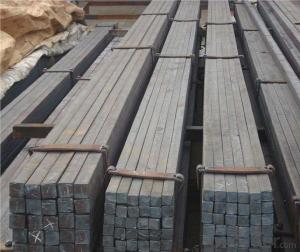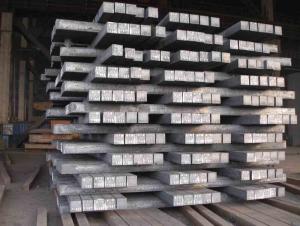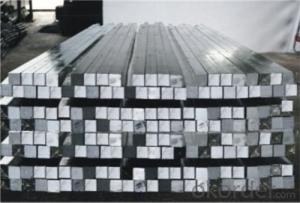Square Steel Cold Drawn with High Quality
- Loading Port:
- China main port
- Payment Terms:
- TT or LC
- Min Order Qty:
- 50 m.t.
- Supply Capability:
- 10000 m.t./month
OKorder Service Pledge
OKorder Financial Service
You Might Also Like
Product Description:
OKorder is offering Square Steel Cold Drawn with High Quality at great prices with worldwide shipping. Our supplier is a world-class manufacturer of steel, with our products utilized the world over. OKorder annually supplies products to European, North American and Asian markets. We provide quotations within 24 hours of receiving an inquiry and guarantee competitive prices.
Product Applications:
Square Steel Cold Drawn with High Quality are ideal for structural applications and are widely used in the construction of buildings and bridges, and the manufacturing, petrochemical, and transportation industries.
Product Advantages:
OKorder's Square Steel Cold Drawn with High Quality are durable, strong, and resist corrosion.
Main Product Features:
· Premium quality
· Prompt delivery & seaworthy packing (30 days after receiving deposit)
· Corrosion resistance
· Can be recycled and reused
· Mill test certification
· Professional Service
· Competitive pricing
Product Specifications:
Standard | GB | HRB400 | ||||||||
Diameter | 6mm,8mm,10mm,12mm,14mm,16mm,18mm,20mm, 22mm,25mm,28mm,32mm,36mm,40mm,50mm | |||||||||
Length | 6M, 9M,12M or as required | |||||||||
Place of origin | Hebei, China mainland | |||||||||
Advantages | exact size, regular package, chemical and mechanical properties are stable. | |||||||||
Type | Hot rolled deformed steel bar | |||||||||
Brand name | DRAGON | |||||||||
Grade | Technical data of the original chemical composition (%) | |||||||||
C | Mn | Si | S | P | V | |||||
HRB400 | ≤0.25 | ≤1.60 | ≤0.80 | ≤0.045 | ≤0.045 | 0.04-0.12 | ||||
Physical capability | ||||||||||
Yield Strength (N/cm²) | Tensile Strength (N/cm²) | Elongation (%) | ||||||||
≥400 | ≥570 | ≥14 | ||||||||
Packaging & Delivery of HRB400 Deformed Steel Bar:
Packaging Detail: products are packed in bundle and then shipped by container or bulk vessel, deformed bar is usually naked strapping delivery, when storing, please pay attention to moisture proof. The performance of rust will produce adverse effect.
Each bundle weight: 2-3MT, or as required
Payment term: TT or L/C
Delivery Detail: within 45 days after received advanced payment or LC.
Label: to be specified by customer, generally, each bundle has 1-2 labels
Trade terms: FOB, CFR, CIF
FAQ:
Q1: Why buy Materials & Equipment from OKorder.com?
A1: All products offered byOKorder.com are carefully selected from China's most reliable manufacturing enterprises. Through its ISO certifications, OKorder.com adheres to the highest standards and a commitment to supply chain safety and customer satisfaction.
Q2: How do we guarantee the quality of our products?
A2: We have established an advanced quality management system which conducts strict quality tests at every step, from raw materials to the final product. At the same time, we provide extensive follow-up service assurances as required.
Q3: How soon can we receive the product after purchase?
A3: Within three days of placing an order, we will begin production. The specific shipping date is dependent upon international and government factors, but is typically 7 to 10 workdays.
Images:


- Q:Can a steel square be used for marking out finger joints?
- Yes, a steel square can be used for marking out finger joints.
- Q:Can a steel square be used for measuring pipe angles?
- A steel square can be utilized to measure pipe angles. Commonly used in construction and woodworking, this versatile tool is also known as a framing square or carpenter's square. With its flat, L-shaped design featuring a 90-degree angle and a long blade, it enables the measurement and marking of angles. To measure a pipe angle using a steel square, align one edge of the square with the pipe and adjust it until it is level with the surface of the pipe. From there, you can easily read the angle measurement directly from the square's markings. It is important to note, however, that relying solely on a steel square for measuring pipe angles may not yield the most accurate results, particularly if the pipe has irregular contours or bends. In such cases, employing specialized tools like protractors or digital angle finders may be more suitable for obtaining precise angle measurements. Furthermore, when measuring pipe angles, it is crucial to take into consideration the pipe's diameter and the specific requirements of the project. Other factors, including the fitting type and the desired angle, may also influence the choice of measurement tool.
- Q:What are some common uses for a steel square in cabinetry?
- A steel square, also referred to as a framing square or carpenter's square, holds great importance in cabinetry due to its versatility. It serves various purposes, some of which include: 1. Layout and marking tasks: In cabinetry, precise marking of straight lines, right angles, and exact measurements is crucial. A steel square aids in these tasks, ensuring accurate markings for different cuts and joints. 2. Checking for squareness: To guarantee proper alignment and fit in cabinetry, precise squareness is necessary. A steel square is employed to check the squareness of panels, corners, and joints, ensuring correct alignment of all components. 3. Marking and cutting angles: For many cabinetry projects, angled cuts are required, such as mitered corners or beveled edges. A steel square acts as a guide for marking and cutting precise angles, ensuring accurate achievement of desired angles. 4. Measurement and transferring measurements: Due to its straight edges and measurement scales, a steel square proves useful for measuring and transferring measurements in cabinetry. It enables precise measurements of lengths, widths, and depths, ensuring accuracy throughout the construction process. 5. Checking and marking for level and plumb: In order to ensure stability and proper functionality, cabinetry needs to be level and plumb. A steel square aids in checking and marking level and plumb lines, ensuring correct installation of cabinets. 6. Creating and checking right angles: Right angles play a fundamental role in cabinetry construction. A steel square facilitates the creation of right angles by aligning its edges with the workpiece, ensuring proper alignment and squareness of corners and joints. All in all, a steel square is an essential tool for any cabinetmaker or carpenter, offering accuracy in layout, measurement, and alignment. Its precision and versatility make it indispensable in the field of cabinetry.
- Q:What is the history of steel squares?
- Steel squares have a long and rich history, dating back to ancient times. The concept of a square tool for measuring right angles can be traced back to the ancient Egyptians and Mesopotamians. However, it was during the 18th and 19th centuries that steel squares as we know them today began to emerge. These squares were initially made from cast iron and gradually evolved into being made from steel, which provided increased durability and accuracy. They became an essential tool for carpenters, masons, and other craftsmen, enabling them to measure and mark right angles with precision. Over the years, steel squares have undergone technological advancements, such as incorporating additional measurements and features like protractors and scales. They continue to be widely used in various industries for layout work, framing, and woodworking. In summary, the history of steel squares is one of evolution and refinement, starting from ancient origins to becoming an indispensable tool for professionals across different trades.
- Q:Can a steel square be used for checking the plumbness of a beam?
- No, a steel square is not typically used for checking the plumbness of a beam. A plumb bob or a spirit level would be more suitable tools for this task.
- Q:How do you use a steel square to measure the height of a doorway?
- To use a steel square to measure the height of a doorway, you would simply place the square vertically against the side of the doorway, ensuring one edge of the square is flush against the floor. Then, read the measurement on the vertical side of the square to determine the height of the doorway.
- Q:Can a steel square be used for measuring angles in welding?
- Indeed, measuring angles in welding can be achieved by utilizing a steel square. The steel square, which is also referred to as a framing square or a carpenter's square, is a highly adaptable tool extensively utilized in construction and welding. With its distinctive right angle shape, the steel square is equipped with markings and measurements on its surface. While it may not possess the same level of precision as specialized angle measuring instruments such as protractors or angle finders, a steel square can still serve effectively in measuring and marking angles in welding. To measure an angle using a steel square, one can align a side of the square with the reference line or surface, and subsequently employ the other side to ascertain the desired angle. The degree markings on the square facilitate accurate determination of the angle. Furthermore, the straight edge of the square can be employed to draw lines or execute cuts at specific angles. It is crucial to acknowledge, however, that the accuracy of the measurement hinges upon the precision of the steel square and the proficiency of the user. If elevated levels of accuracy are essential, it is advisable to employ specialized angle measuring instruments or digital angle finders that offer more meticulous measurements.
- Q:It can be used as the steel electrical equipment grounding
- In the electrical grounding body, generally use the steel pipe, angle steel, flat steel, round steel and other steel specially made grounding. The artificial grounding body and the ground wire form a grounding device, so that various earthing of the electrical equipment is connected with the ground through a grounding device. The artificial earthing body has two kinds of vertical embedment and horizontal embedment. The vertical buried pipe, angle steel, round steel grounding body, and have sufficient mechanical strength; ground level buried body with round steel, flat steel, common type, with several ring and radiation type. It is better to use galvanized steel when laying artificial earth in strongly corrosive soil. The steel used in the earth body shall be in accordance with the requirements of thermal stability and uniform pressure.
- Q:How do you use a steel square to determine rafter lengths?
- To determine rafter lengths using a steel square, you need to follow a few steps. First, line up the heel of the square against the rafter's bottom edge. Next, locate the common rafter pitch on the square's body and mark it on the rafter. Then, pivot the square until the desired rise measurement aligns with the mark. Finally, read the length measurement on the body of the square, which will give you the accurate rafter length.
- Q:Can a steel square be used for checking the squareness of a bookshelf?
- No, a steel square cannot be used for checking the squareness of a bookshelf. A steel square, also known as a carpenter's square or a try square, is primarily used for measuring and marking right angles in woodworking and carpentry. It is not designed to accurately determine the squareness of a complex structure like a bookshelf. To check the squareness of a bookshelf, a more appropriate tool would be a combination square or a framing square, as these are specifically designed to measure and verify right angles in larger structures. Additionally, a level or a measuring tape can also be used to ensure the bookshelf is level and accurately aligned. Using the correct tools for the task at hand is crucial to achieving accurate and precise results.
1. Manufacturer Overview |
|
|---|---|
| Location | |
| Year Established | |
| Annual Output Value | |
| Main Markets | |
| Company Certifications | |
2. Manufacturer Certificates |
|
|---|---|
| a) Certification Name | |
| Range | |
| Reference | |
| Validity Period | |
3. Manufacturer Capability |
|
|---|---|
| a)Trade Capacity | |
| Nearest Port | |
| Export Percentage | |
| No.of Employees in Trade Department | |
| Language Spoken: | |
| b)Factory Information | |
| Factory Size: | |
| No. of Production Lines | |
| Contract Manufacturing | |
| Product Price Range | |
Send your message to us
Square Steel Cold Drawn with High Quality
- Loading Port:
- China main port
- Payment Terms:
- TT or LC
- Min Order Qty:
- 50 m.t.
- Supply Capability:
- 10000 m.t./month
OKorder Service Pledge
OKorder Financial Service
Similar products
New products
Hot products
Related keywords



























